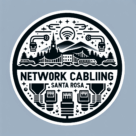Is Fiber Optic a Cable? Understanding How It Works and Why It’s the Future of Connectivity
If you’ve ever wondered, “Is fiber optic a cable?”, the short answer is yes — but it’s not like the regular copper cables you might be familiar with. Fiber optic cables use light instead of electricity to transmit data, making them one of the fastest and most reliable ways to connect to the internet today. Our experienced structured cabling technicians in Santa Rosa ensure every fiber optic and copper network setup meets the highest performance standards.
Whether you’re upgrading your home network, installing new CCTV systems, or improving business communications, understanding how fiber optic cables work can help you make smarter, future-ready decisions.
What Is a Fiber Optic Cable?
A fiber optic cable is a type of network cable made up of thin strands of glass or plastic fibers. Each strand, roughly the thickness of a human hair, carries data as pulses of light.
These light signals are transmitted through the core of the cable and reflected along its length, allowing information to travel long distances at incredible speeds — much faster than traditional copper wiring.
A typical fiber optic cable has three main parts:
- Core – The center part that carries the light signals.
- Cladding – A protective layer that reflects the light back into the core.
- Outer coating – Shields the cable from damage, moisture, and interference.
This unique construction allows fiber optics to deliver fast, stable, and high-bandwidth data transfer with very little signal loss.
How Fiber Optic Cables Work
Instead of transmitting electrical signals, fiber optics use light waves — often generated by lasers or LEDs. These light pulses represent digital data and can travel over long distances with minimal degradation.
Because light moves so quickly, fiber cables can handle massive amounts of information simultaneously. That’s why fiber internet can deliver gigabit speeds that copper or coaxial cables simply can’t match.
For example:
- A CAT6 cable might handle speeds up to 10 Gbps over short distances.
- A fiber optic cable can reach 100 Gbps or more, even across miles of distance.
Types of Fiber Optic Cables
There are two main types of fiber optic cables used in network and security installations:
- Single-Mode Fiber (SMF)
- Has a very thin core (about 9 microns).
- Carries a single light beam for long-distance transmission.
- Ideal for large networks, data centers, and telecommunication lines.
- Multi-Mode Fiber (MMF)
- Has a thicker core (about 50–62.5 microns).
- Carries multiple light beams at once.
- Best suited for shorter runs — like within buildings or campuses.
Both types deliver incredible speed and reliability, but the right choice depends on your specific application and distance requirements.
Benefits of Using Fiber Optic Cables
Switching to fiber optic cabling offers major advantages for both residential and commercial installations:
- Lightning-fast speeds – Transfer data at gigabit and even terabit levels.
- Long-distance performance – Minimal signal loss over miles of cable.
- High bandwidth – Supports streaming, cloud computing, and CCTV systems.
- No interference – Immune to electromagnetic and radio frequency noise.
- Future-proof technology – Designed for evolving internet and networking demands.
For modern businesses, schools, and smart homes, fiber optics provide a long-term investment that ensures smooth performance even as data demands grow.
Fiber Optic vs. Traditional Copper Cabling
| Feature | Fiber Optic | Copper (CAT5e/CAT6) |
|---|---|---|
| Data Transmission | Light pulses | Electrical signals |
| Speed | Up to 100 Gbps+ | Up to 10 Gbps |
| Distance | Several miles | Up to 100 meters |
| Signal Interference | None | Susceptible |
| Cost | Higher upfront | Lower upfront |
| Longevity | Longer lifespan | Moderate lifespan |
While copper cabling is still reliable for small-scale or budget installations, fiber optics are rapidly becoming the gold standard for modern infrastructure.
Where Fiber Optic Cabling Is Commonly Used
Fiber optic cabling is used in a wide range of industries and environments across California and beyond, including:
- Internet service providers – For high-speed broadband networks.
- Businesses and offices – Reliable connections for servers and VoIP systems.
- Educational campuses – High-capacity internet for classrooms and labs.
- Security systems – Fast video transmission for HD and 4K CCTV feeds.
- Data centers – Backbone infrastructure for cloud and enterprise systems.
Wherever high performance and reliability matter, fiber optics lead the way.
Is Fiber Optic Right for You?
If your current network struggles with slow speeds, interference, or signal loss, switching to fiber optic cabling could be the solution. It’s perfect for expanding businesses, remote work setups, and smart home systems that depend on strong, stable internet connections.
Professional installation ensures your fiber system meets performance standards, building codes, and safety requirements — giving you dependable connectivity for years to come. Understanding the role of fiber optics is easier when you know why network cabling is essential for reliable communication and data transfer.
Upgrade to Fiber Optic Cabling Today
Whether you’re in Los Angeles, San Francisco, or anywhere in California, investing in fiber optic installation is one of the best ways to future-proof your network. Certified technicians can help you choose the right type of fiber, plan your layout, and install everything to industry standards.
Enjoy faster speeds, greater reliability, and peace of mind knowing your network is built for the future.
Contact your local fiber optic installation experts today to get started with a custom-designed solution that fits your needs.
